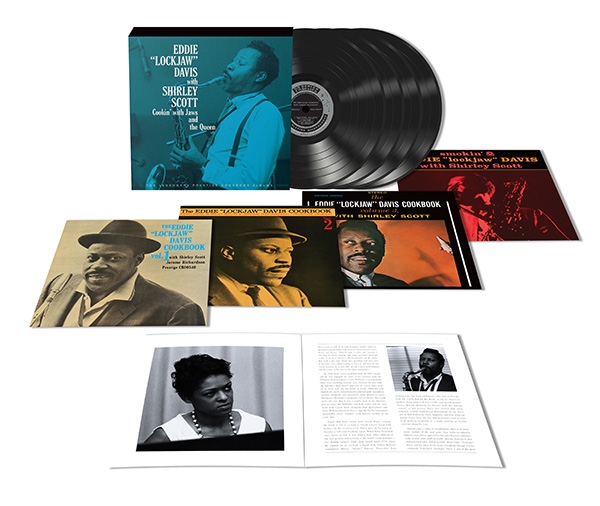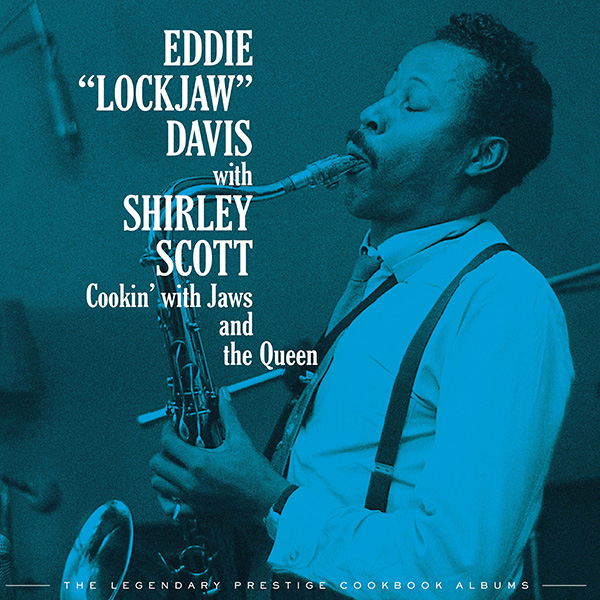| Columns Retired Columns & Blogs |
You actually sent me scurrying off to Craft to grab a set.

In three 1958 sessions at Rudy Van Gelder's Hackensack, New Jersey, "living room" studio, Davis and Scott recorded four seminal soul-jazz albums, the "Cookbooks." Themed around bluesy originals and spirited takes on comfortable standards, the albums featured liner notes and song titles that relate to an imagined soul kitchen, with a generous helping of kitschy references to the "simmerin'" music on the platters. The biggest hit was "In the Kitchen," from the first album, which became a staple of jazz radio shows in the late '50s and early '60s and was issued as a two-part jukebox single. The album version clocks in at nearly 13 minutes.
Craft Recordings, the reissue label for the Concord Music Group, has collected the four "Cookbook" albums into a box set of vinyl cut from the two-track master tapes by Bernie Grundman and plated and pressed at RTI in California. Cookin' With Jaws and the Queen features original stereo-release cover art and a nicely illustrated 12×12 booklet with an essay by Willard Jenkins. The physical product looks and feels deluxe, and the platters are superbly cut and pressed quiet and flat. This kind of presentation is why people pay extra for vinyl. The music was also released as a four-CD box with some extra tracks, and it streams in a range of formats, from lossy to 24/192.

The Eddie "Lockjaw" Davis Cookbook, originally issued with a different cover and in mono, was recorded June 20, 1958, and released later that year (footnote 1). Its unexpected success on radio and jukeboxes prompted Prestige owner Bob Weinstock to hold a December 5, 1958, session for Cookbook Volume 2, which was issued in 1959, again in mono and with a different cover (footnote 1). Both albums featured Davis and Scott with bassist George Duvivier and drummer Arthur Edgehill. But the secret sauce at those sessions was multi-instrumentalist guest Jerome Richardson, who played flute, baritone, and tenor sax. Richardson's flute was a unique flavor in the musical stew, especially on deep blues numbers like "In the Kitchen" and "The Skillet." This new ingredient to soul jazz made the albums stand out.
The same group (sans Richardson) gathered on September 12, 1958—between the June and December sessions—to record Davis's Prestige album Jaws. This quartet session turned out to be productive, and extra songs were included on Cookbook Volume 3, issued in 1961, and Smokin', in 1963, along with extras from the December session. The first 2 "Cookbooks" were first issued in stereo in the mid-1960s.
This is music for enjoyment among friends or late night with a comfortably stiff drink. It's not navel-gazing, obtuse, or an acquired taste (unless you don't like rhythm and soul). The tempos vary from blistering bebop-fast to funeral march slow walking blues. Duvivier and Edgehill lay a solid foundation and maintain forward momentum. Scott revels in the rhythm pocket, eschewing the bass pedals—there's a bass player after all—and concentrating on percussive accent chords and soulful runs that would be at home in an urban chapel. Jaws spreads fire everywhere, alternating liquid lyricism with full-on power blowing. When he and Richardson are both playing sax, the contrast is perfect, the flavors distinct.
The "Cookbooks" burst out of the gate with "Have Horn, Will Blow," but they hit their stride on Side 2 of Volume 1. "In the Kitchen" would be at home on a pure blues album, except for Richardson's deep-digging flute solo. The track fades out into a sea of Van Gelder plate reverb, a technique reprised on at least one slow number on each of the subsequent "Cookbooks." The album ends with the fast, jovial "Three Deuces," named for a late, great NYC jazz club.
Volume 2's best side is the first. Opening with another slow-boiler, "The Rev"—a sax-organ call-and-response right outta church—it closes with a heartfelt rendering of the classic "Stardust," featuring tasty, close-miked brushwork by Edgehill. Side 2 is no slouch, especially the two Davis-Scott originals, "Skillet" and "The Broilers." The two later albums are more of a gumbo, not as tightly sequenced or themed but offering plenty of musical nourishment.
In 1958, Rudy Van Gelder was still figuring out mono-stereo compatibility. A one-man operation, he didn't have the time to edit separate full-track mono and 2-track stereo master tapes. So he came up with a system called "50-50," which involved recording to 2-track "stereo" (really, in today's lingo, two separate mono mixes, one per channel) and monitoring the sessions in mono to assure his two tracks could be summed to cut mono LPs, by far the bread-and-butter medium for music at that time (footnote 3).
The result of all this—and its relevance here—is that the stereophony sounds different in each of the three recording sessions, a small annoyance and the only criticism I have about this set.
Davis, Scott, and company laid down a feast for the ages, and the Craft crew have done their best to serve it up for a new century.
Footnote 2: See bit.ly/3IKXIjx.
Footnote 3: See bit.ly/3ZvIWUI. For more information on these issues, see Rich Capeless's excellent "RVG Legacy" website, rvglegacy.org.

You actually sent me scurrying off to Craft to grab a set.